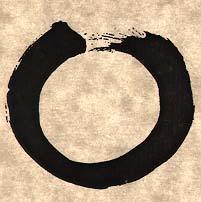Zen following fades in East as it grows in
West
Religion News Service
 KYOTO,
Japan -- Every morning, Buddhist priest Taiun Mastunami invites the public to
participate in zazen - seated Zen meditation - from 7 to 8 a.m. at his small, well-tended
Kyoto temple, Ryosen-an. A sign announcing the schedule is posted outside in Japanese and
English.
KYOTO,
Japan -- Every morning, Buddhist priest Taiun Mastunami invites the public to
participate in zazen - seated Zen meditation - from 7 to 8 a.m. at his small, well-tended
Kyoto temple, Ryosen-an. A sign announcing the schedule is posted outside in Japanese and
English.
Most mornings he sits by
himself.
Zen Buddhism is deeply
woven into Japanese culture. Its fusion of philosophy, spirituality and art is one of the
world's great cultural achievements. The Zen emphasis on spontaneity and the abandonment
of fear shaped the samurai warrior code. Zen rituals, which point to the transcendent in
ordinary life, spawned the intricate choreography of the tea ceremony.
But over the past 200
years, Zen has fallen far from its peak of cultural influence. Today it's neither popular
nor particularly influential in modern Japan. Zen temples still draw visitors on holidays
and some turn to Zen priests to officiate at funerals. But very few Japanese practice Zen,
and the numbers are declining, especially among the young.
That decline has
coincided with Buddhism's flourishing in the West. Zen and other forms of Buddhism are
steadily growing in popularity in the United States, Europe and elsewhere. Practice
centers are drawing new members, and Buddhism has become a force in popular culture
through books and movies.
This seesaw effect has
created tensions between the past and present, between East and West -- and poses a kind
of Zen riddle for Japanese and foreign Zen practitioners alike.
What happens when a
traditional religion, tempered by one culture, crosses boundaries and takes hold somewhere
else? In both Japan and the United States, practitioners say Zen must change and adapt to
different cultures.
"The basic principle
in Zen is the same everywhere. Like Mount Fuji, there are different paths to the
summit," said Kusho Itabashi, the abbot of the Soji-ji monastery in Yokohama and the
current head of the Soto school, the largest Zen sect. "Americans don't have to go
through the medium of Japanese culture or language, and that can be a purer practice of
Zen."
But in Japan, the changes
are sparking anxiety. Japanese feel proprietary about Zen. They worry that its
characteristic "Japaneseness" may be almost impossible to separate from the
universal philosophy it espouses, and that something will be lost when it takes root
somewhere else.
Zen has a distinctly
different feel in the United States than in Japan.
"American Zen
practice is creative," said Matsunami, who spent several years in the United States
and whose temple has a tradition of hosting Westerners. "They don't have meditation
halls, traditions. They have to create everything. They have to sew cushions ... and they
have to turn the cow house into a zendo."
But at the same time, he
noted, American Zen has been plagued by a number of scandals among its leaders, partly
because it lacks the hierarchies and checks on priestly power found in Japanese Zen.
The Japanese system is
much more established and institutionalized, he said, focused around monastic practice in
small monasteries rather than the more lay-oriented Western approach. But it has also lost
some of its vitality and discipline.
"Here, everything is
established, we have good facilities," Matsunami said. "But here they also
accept not pure, not real Buddhist monks' practice. In other countries, priests don't
marry, they don't drink."
A loosening of monastic
rules a century ago allowed Japanese monks to marry. That created a dynastic structure in
temples, with sons following in their fathers' footsteps. Many Zen priests and scholars
agree with Matsunami that this has created problems: It placed an emphasis on the temple
as a moneymaking business to be passed on to succeeding generations, and meant that many
young men became monks mainly out of family obligation. Sources of fresh blood and new
ideas were choked off.
As a result, the
monastery system seems outmoded. Religious life is no longer viewed as a viable vocation
for outsiders. The requirements and hardships of the priesthood -- which in a premodern
world seemed like a reasonable tradeoff -- today can present almost insurmountable
obstacles.
In the Rinzai school, one
of the two largest branches of Zen, "there are 39 Rinzai monasteries and 50 roshi
[masters] who can give the whole transmission of the teachings. So there's just about one
per monastery," said Michel Mohr, a professor at the International Research Institute
for the Study of Zen Buddhism at Hanazono University in Kyoto. "It takes 15 to 20
years to go through the whole system. So if you start in your 30s, you won't get there
till your 50s."
Japanese Zen
practitioners feel deeply ambiguous about this state of affairs. Many look to the West as
the best hope for carrying on the tradition. But some are dismayed at what they see when
Westerners are left to their own devices.
Western Zen practitioners
in Japan live on a fault line. Since they typically lack a connection to a family temple,
Japanese may question their motivation or sanity. They must wrestle with the idea of what
"authentic" Zen practice really is.
Jeff Shore, an
American professor of Zen at Hanazono University in Kyoto, has lived in Japan 20 years,
most of them while practicing first as a monk and later a lay person at the Tofuku-ji
monastery. It is an unusual arrangement that has made a deep mark on his life. "I
feel like the frog in the well here. It's very deep but very narrow, full of rocks,
old," he said. "Then when I go to Europe or the United States, it's like being
thrown into the ocean."
Source: http://www.religionnews.com